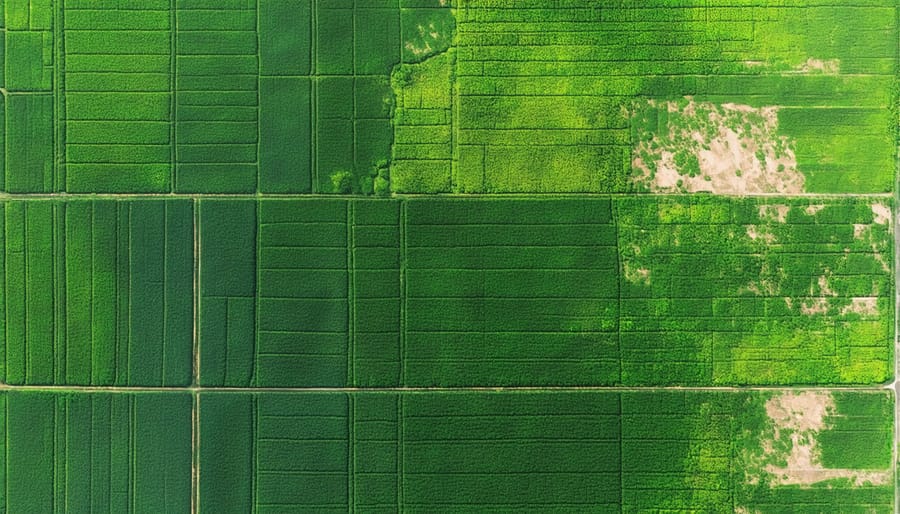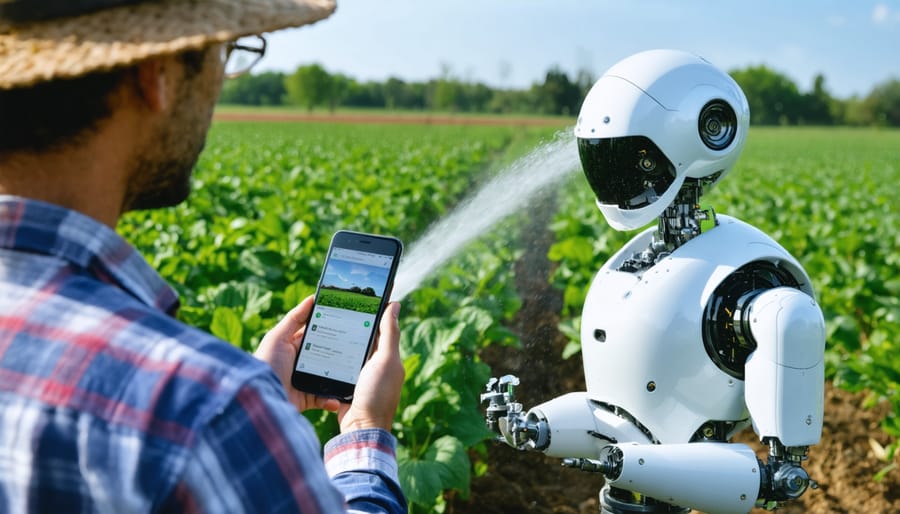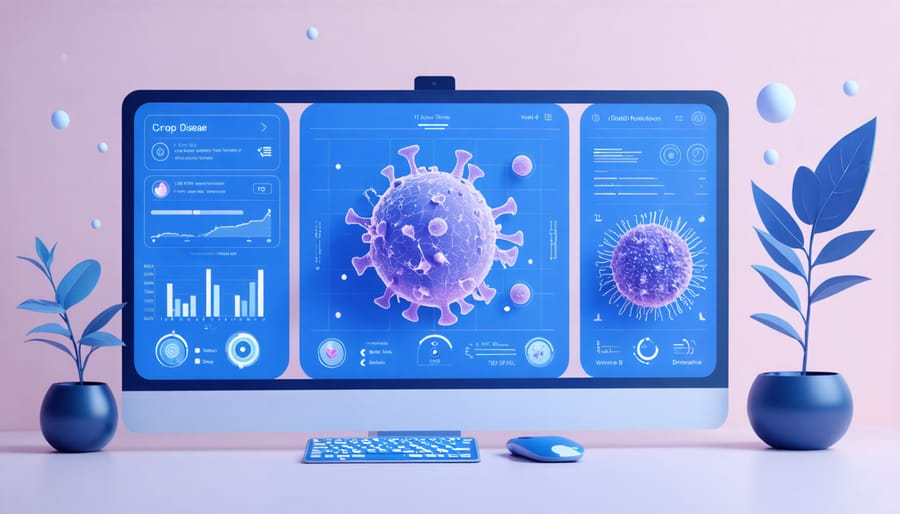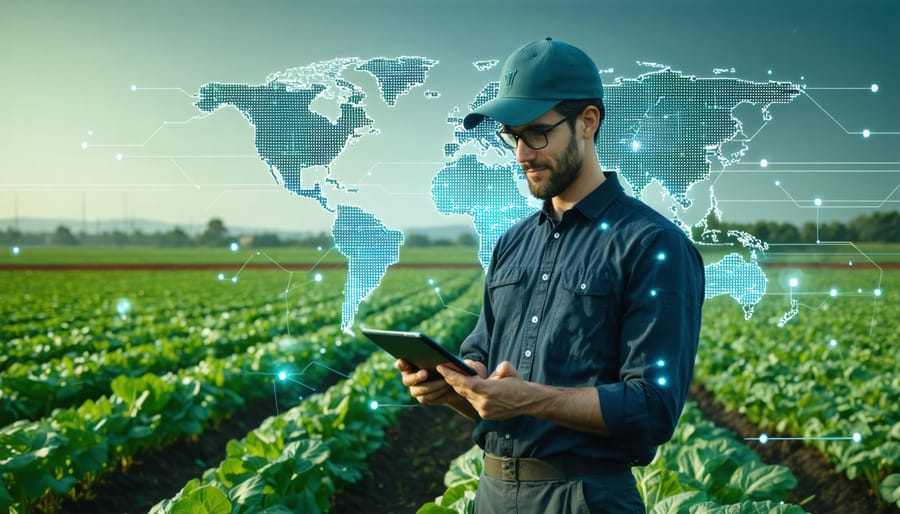In the global fight against hunger and agricultural challenges, USAID’s innovative integration of artificial intelligence is revolutionizing farming practices across developing nations. From precision agriculture in Rwanda to smart irrigation systems in Kenya, USAID’s agricultural initiatives are leveraging AI technologies to transform traditional farming into data-driven, sustainable operations. These technological advancements have already helped over 2 million smallholder farmers increase their crop yields by an average of 30% while reducing water usage and environmental impact.
The intersection of USAID’s agricultural development programs and artificial intelligence represents a pivotal shift in how we approach global food security. By combining satellite imagery, machine learning algorithms, and mobile technology, USAID is enabling farmers to make more informed decisions about planting times, crop selection, and resource management. This tech-forward approach not only improves agricultural productivity but also strengthens resilience against climate change and market fluctuations.
The agency’s commitment to incorporating AI-driven solutions has created a new paradigm in international agricultural development, where data analytics and predictive modeling help bridge the gap between subsistence farming and sustainable agricultural enterprises. Through strategic partnerships with tech companies and local organizations, USAID is building a future where artificial intelligence serves as a catalyst for agricultural transformation in the world’s most vulnerable regions.
USAID’s AI-Powered Agricultural Revolution
Current AI Implementation in USAID Projects
USAID is actively implementing AI technologies across various agricultural projects to enhance farming efficiency and sustainability. In Kenya, the agency has deployed machine learning algorithms to analyze satellite imagery for early detection of crop diseases and pest infestations, helping farmers take preventive measures before significant damage occurs.
Another notable implementation is the Smart Farming Initiative in India, where AI-powered mobile apps provide smallholder farmers with personalized crop recommendations and weather forecasts. These apps process local climate data, soil conditions, and market prices to suggest optimal planting times and crop varieties.
In Southeast Asia, USAID’s Digital Agriculture Program utilizes AI-driven sensors to monitor soil moisture levels and nutrient content. This technology enables precise irrigation scheduling and fertilizer application, reducing water waste and improving crop yields by up to 30%.
The agency has also introduced predictive analytics tools in Ethiopia that help forecast potential food security risks by analyzing historical weather patterns, crop yields, and market data. This system enables better preparation for potential agricultural challenges and more efficient resource allocation.
Success Stories and Impact Metrics
USAID’s AI-powered agricultural initiatives have demonstrated remarkable success across multiple regions. In Ethiopia, machine learning algorithms helped improve crop yield predictions by 85%, enabling better resource allocation and farmer support. The program directly benefited over 50,000 smallholder farmers in its first year.
In Kenya, USAID’s digital agriculture platform integrated with AI-driven supply chain optimization resulted in a 40% reduction in post-harvest losses and increased farmer incomes by 30%. The system connects over 100,000 farmers with market opportunities and provides real-time pricing information.
Bangladesh’s smart irrigation project, powered by AI sensors and weather forecasting, achieved a 25% reduction in water usage while maintaining crop yields. This initiative reached 75,000 farmers and contributed to sustainable water management practices.
In Guatemala, AI-enabled pest detection systems helped prevent potential crop losses worth $2.5 million by identifying early signs of disease outbreaks. The technology’s 92% accuracy rate in pest identification has made it a model for similar programs across Central America.
Key AI Technologies Driving Agricultural Innovation
Satellite Imaging and Predictive Analytics
USAID has revolutionized agricultural monitoring through advanced environmental analysis technologies that combine satellite imaging with AI-powered predictive analytics. This innovative approach processes vast amounts of satellite data to track crop health, predict yields, and identify potential agricultural challenges before they become critical issues.
The system works by analyzing multiple data layers from satellite imagery, including infrared readings, moisture levels, and vegetation indices. AI algorithms process these inputs to create detailed maps of farming regions, monitoring changes in crop patterns, and detecting early signs of stress such as drought or pest infestations.
Machine learning models trained on historical crop data can predict harvest yields with increasing accuracy, helping USAID and local farmers make informed decisions about resource allocation and farming strategies. These predictions consider various factors such as weather patterns, soil conditions, and historical yield data to provide actionable insights.
Real-time monitoring capabilities allow for rapid response to emerging issues. When the system detects potential problems, it automatically alerts agricultural extension workers who can then provide targeted support to affected areas. This proactive approach has significantly improved crop management and reduced losses in USAID-supported regions.
The technology also helps track the effectiveness of agricultural interventions, providing valuable data for program optimization and resource allocation. This data-driven approach ensures that aid efforts are directed where they can have the most significant impact.

Smart Irrigation Systems
USAID’s implementation of smart irrigation systems represents a significant leap forward in agricultural water management. By integrating AI-powered sensors and smart resource management systems, these solutions help farmers optimize water usage while maximizing crop yields.
The system works by collecting real-time data from soil moisture sensors, weather stations, and satellite imagery. AI algorithms process this information to determine precise irrigation schedules, taking into account factors such as soil type, crop requirements, and local weather patterns. This targeted approach can reduce water consumption by up to 30% while improving crop health and productivity.
In drought-prone regions, these systems have proven particularly valuable. Farmers receive automated alerts through mobile apps, informing them of optimal watering times and potential issues. The technology also adapts to changing conditions, automatically adjusting irrigation patterns based on rainfall forecasts and soil moisture levels.
USAID’s programs have successfully implemented these systems in several developing countries, providing training and support to local farmers. The technology has been particularly impactful in regions like sub-Saharan Africa, where water conservation is crucial for sustainable agriculture. By combining traditional farming knowledge with AI-driven insights, these systems help create more resilient and sustainable agricultural practices while conserving precious water resources.

Disease Detection and Prevention
USAID has revolutionized disease detection and prevention in agriculture through innovative AI-powered solutions. Computer vision and machine learning algorithms now enable farmers to identify crop diseases quickly and accurately using just their smartphones. By capturing photos of affected plants, these tools can analyze symptoms and provide immediate diagnoses, helping farmers take swift action to prevent disease spread.
In partnership with local agricultural institutions, USAID has implemented early warning systems that use AI to predict disease outbreaks before they become widespread. These systems analyze various data points, including weather patterns, soil conditions, and historical disease occurrence, to alert farmers about potential risks and recommend preventive measures.
A notable success story comes from East Africa, where USAID’s AI-powered disease detection program helped contain a devastating cassava virus. The system identified early signs of the disease with 93% accuracy, enabling farmers to isolate affected plants and protect their harvests. This intervention saved millions of dollars in potential crop losses and protected food security for thousands of families.
The technology also supports sustainable farming practices by promoting targeted treatment approaches. Instead of blanket application of pesticides, farmers can now identify specific disease locations and apply treatments precisely where needed, reducing chemical usage and environmental impact while saving costs.

Challenges and Future Directions
Infrastructure and Training Needs
USAID’s agricultural initiatives heavily emphasize developing robust infrastructure and enhancing local capacity through comprehensive training programs. The organization focuses on building essential agricultural facilities, including storage units, processing centers, and irrigation systems, which form the backbone of sustainable farming practices in developing regions.
A key component of USAID’s infrastructure development includes establishing digital networks and mobile connectivity in rural areas, enabling farmers to access real-time market information and weather forecasts. These technological improvements help farmers make informed decisions about planting, harvesting, and selling their produce.
Training programs are designed to address both traditional farming techniques and modern agricultural technologies. USAID implements hands-on workshops, demonstration farms, and farmer field schools to teach sustainable farming practices, pest management, and soil conservation techniques. Special attention is given to training local agricultural extension workers who can continue supporting farmers long after initial project completion.
The organization also focuses on building institutional capacity by partnering with local agricultural research centers, universities, and government agencies. These partnerships help create sustainable knowledge transfer systems and ensure long-term project success. Additionally, USAID provides training in business management, financial literacy, and market access strategies, empowering farmers to transform their agricultural activities into profitable enterprises.
Through these infrastructure and training initiatives, USAID creates lasting impact by combining physical development with human capacity building, ensuring communities can maintain and build upon improvements independently.
Emerging Technologies and Opportunities
The future of USAID’s agricultural initiatives is being shaped by groundbreaking AI technologies that promise to revolutionize farming practices in developing nations. Machine learning algorithms are becoming increasingly sophisticated in predicting crop yields, while advanced drone technology combined with computer vision is enabling precise monitoring of vast agricultural landscapes.
One particularly promising development is the emergence of AI-powered soil analysis systems that can provide real-time recommendations for optimal fertilizer use and irrigation scheduling. These sustainable AI solutions are helping farmers make data-driven decisions while minimizing environmental impact.
Mobile applications powered by AI are also transforming how farmers access information and market their products. These apps can provide instant disease diagnosis through photo recognition, offer personalized crop management advice, and connect farmers directly with buyers through AI-matched marketplaces.
Looking ahead, USAID is exploring the potential of blockchain technology combined with AI to create transparent supply chains and ensure fair pricing for farmers. Additionally, the integration of IoT sensors with AI analytics is expected to enable more precise weather forecasting and automated irrigation systems, making agriculture more resilient to climate change.
These emerging technologies are not just improving efficiency; they’re creating new opportunities for smallholder farmers to participate in the global agricultural economy while promoting sustainable farming practices.
As we look to the future, the integration of AI in USAID’s agricultural initiatives represents a pivotal shift in how we approach global food security and agricultural development. By harnessing the power of artificial intelligence, USAID is not just improving current farming practices but revolutionizing the entire agricultural landscape in developing nations.
The combination of machine learning algorithms, satellite imaging, and data analytics is enabling more precise decision-making, from crop selection to resource allocation. This technology-driven approach is helping farmers increase yields while using fewer resources, making agriculture more sustainable and resilient to climate change.
What makes this transformation particularly promising is its scalability. Solutions that prove successful in one region can be quickly adapted and implemented in others, creating a ripple effect of positive change across multiple communities. The democratization of agricultural technology through USAID’s initiatives is bridging the digital divide and empowering smallholder farmers with tools previously available only to large agricultural operations.
Looking ahead, we can expect to see even more innovative applications of AI in agriculture, from advanced pest prediction systems to automated irrigation solutions. However, the true measure of success will be in how these technologies translate into real-world improvements in food security, farmer livelihoods, and environmental sustainability.
As USAID continues to champion these technological advancements, the future of agriculture in developing nations looks increasingly bright, promising a more food-secure world for generations to come.

